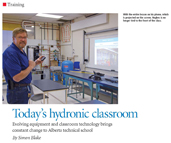HVACR - an industry that offers limitless opportunities that can lead to lifelong, well-paying careers!
No matter what economy, our heat must stay on!
The Canadian HVACR industry's annual sales gross more than $4 billion each year and it employs more than 50,000 workers. The Canadian climate requires that the heat must stay on in both commercial and residential buildings, which means that no matter what the economic state, the expertise of an HVAC professional is always in demand.
More and more, the Canadian economy also depends on effective cooling and refrigeration processes for food and beverage processing and preservation, manufacturing, health care, commercial buildings (offices and retail) as well as Canada's beloved ice rinks.
Today, a university education no longer provides assurance of a well-paying job. And with the rising cost of tuition, more and more graduates are finding themselves saddled with debt and limited career options.
The Canadian Construction Sector Council, meanwhile, foresees continued growth in the construction sector, which includes several skilled trades industries that offer many exciting opportunities for a life-long, well-paying career. The Heating, Ventilation, Air Conditioning and Refrigeration (HVACR) industry, for example, offers the ability to "earn while you learn" without amassing a crushing student debt. An HVACR apprenticeship offers on-the-job training, a competitive salary and, once certified, employment in an industry that is essential to Canadians and remains resilient even during economic slowdowns.
The HVACR industry offers great employment opportunities not only to the service technician who enjoys working with his or her hands but also to youth more focused on the business-side of things.
Ours in an essential industry that meets many needs. For example, did you know that...
Hockey Arenas rely on refrigeration technicians for ice rink maintenance
Hospitals rely on HVACR technicians to maintain sterile and healthy indoor air quality
Home builders rely on HVACR engineers and technicians to ensure proper duct design and equipment installation
HVACR manufacturers and wholesalers rely on industry trained professionals (outside and inside sales representatives, technical writers, etc) to get their products out on the market
Homeowners and Property Managers rely on the HVACR industry to service, install and maintain comfort systems in their homes and buildings
The environment relies on innovative professionals to design, manufacture and install equipment that reduces energy use and utilizes renewable energy
Not just a career for the 'guy with the tool belt'
Men and women entering the HVACR industry can build a career as a:
High School Success Story

Ontario school celebrates six years of graduating licensed gas fitters
Over the past six years students at College Avenue Secondary School in Woodstock, Ontario have been given the opportunity to write their Gas Certification Level 3 license in their own classroom under the guidance of their teacher, Phil Gagnon. As the only high school in Ontario designated as a training provider by TSSA, dozens of students have achieved their Certificate of Qualification over the years.
Today's Hydronic Classroom

"One of the biggest problems is that there is nowhere to dump heat"
The Northern Alberta Institute of Technology (NAIT) in Edmonton has long been known for its training programs in hydronic heating. But like the technology itself, that training is constrantly evolving. The classrooms, labs, teaching and delivery methods look considerably different today than they did just 10 years ago.
NAIT puts a strong emphasis on hands-on work and the labs are continuously being updated with new equipment.
By Simon Blake
